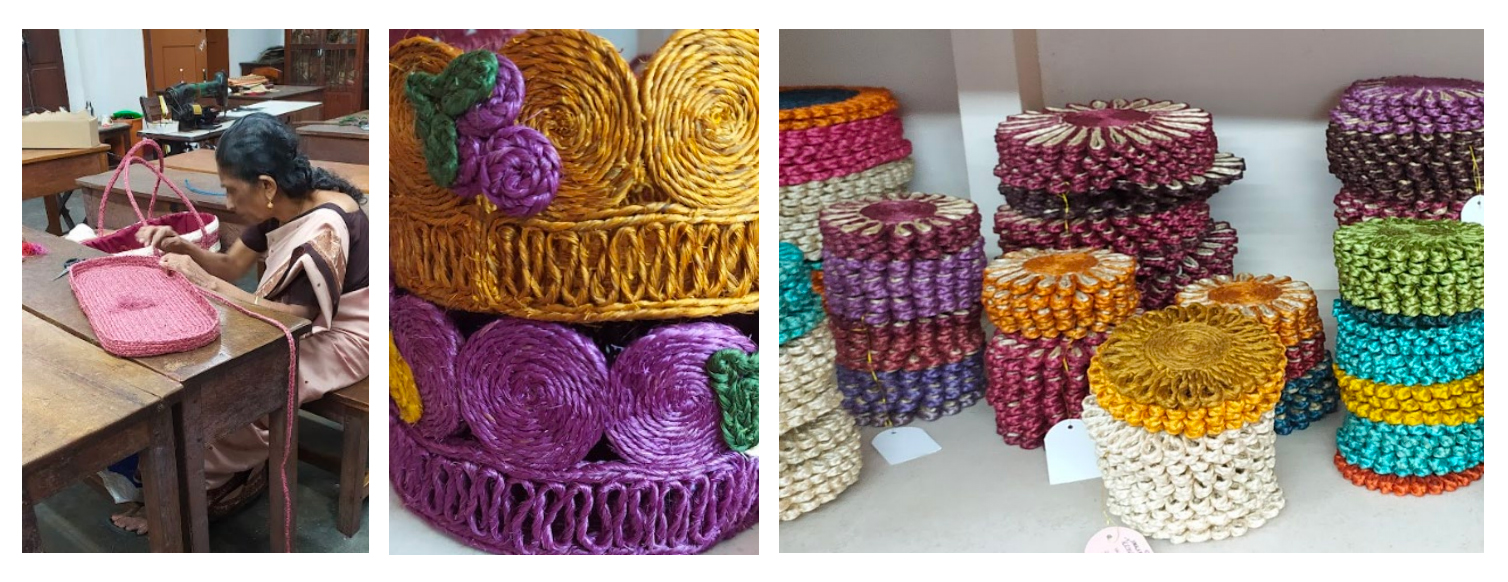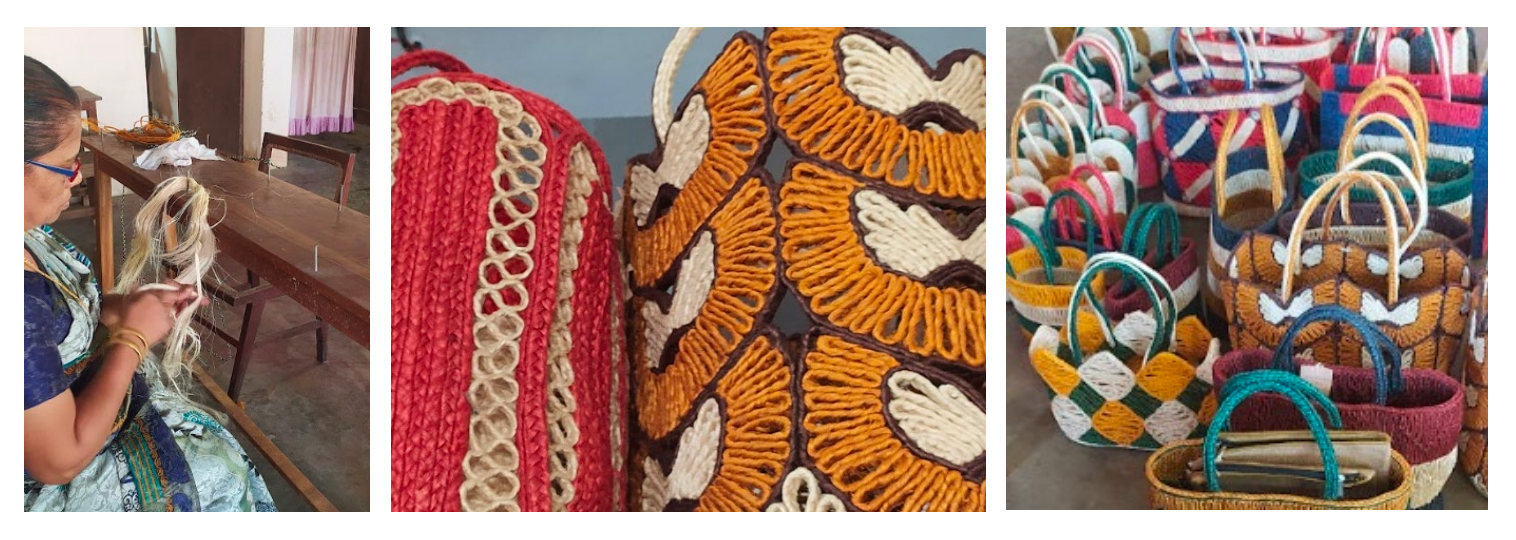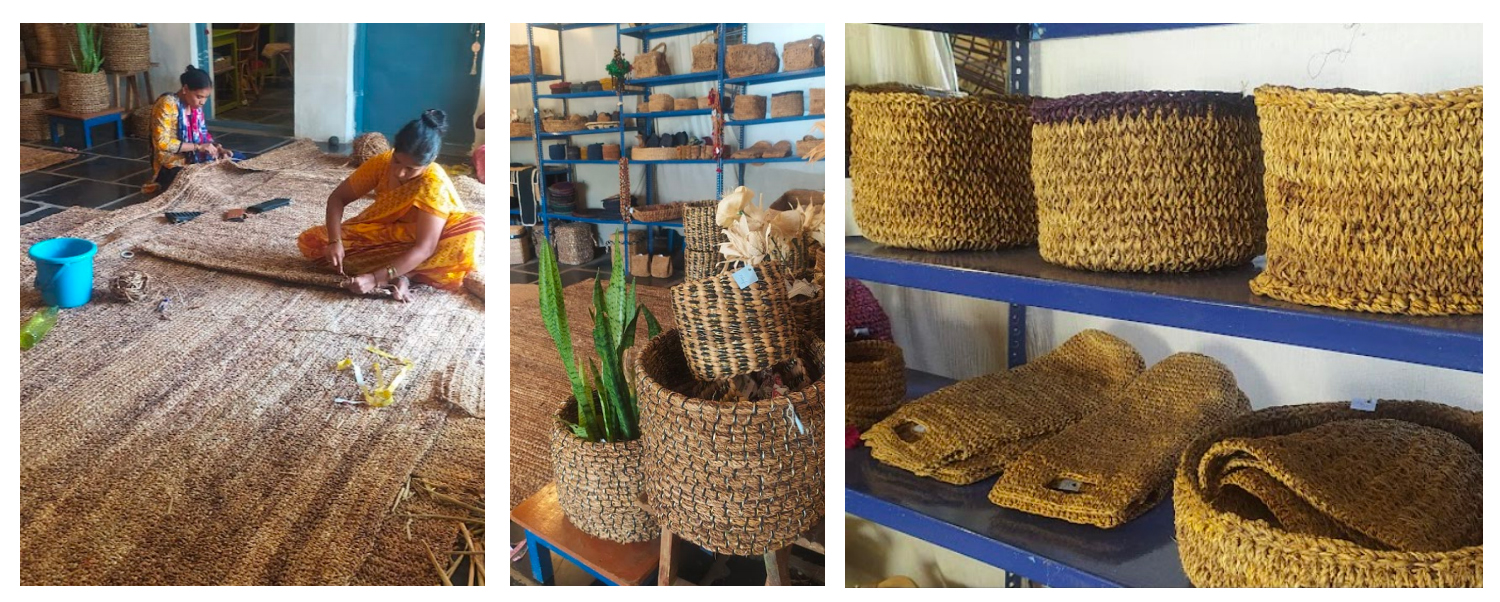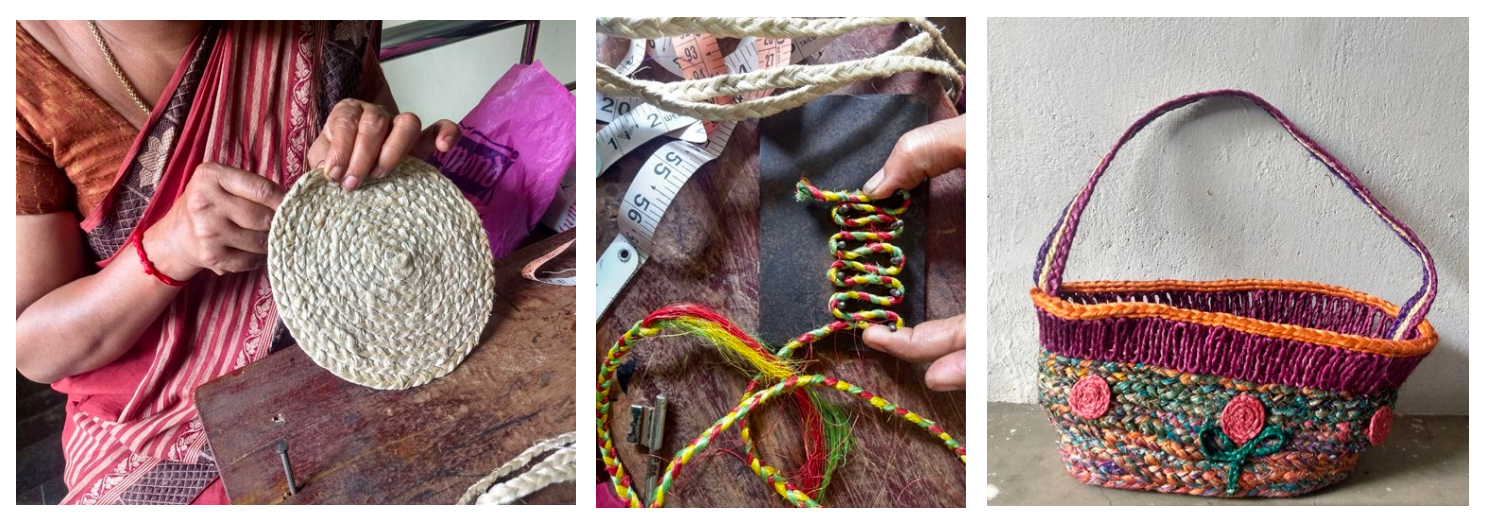Share and Cite
Chicago/Turabian Style
Anooja J. , Nimmi Elizabeth-Thomas and A. L. Abhirami, "The Fourth Craftsperson of India: A Glimpse into the Needs and Challenges of the Banana Fiber Craftswomen." JDSSI 2, no.2 (2024): 9-23.
AMA Style
Anooja J. , Nimmi Elizabeth-Thomas and A. L. Abhirami. The Fourth Craftsperson of India: A Glimpse into the Needs and Challenges of the Banana Fiber Craftswomen. JDSSI. 2024; 2(2): 9-23.
© 2024 by the authors. Published by Michelangelo-scholar Publishing Ltd.
This article is published under the Creative Commons Attribution-NonCommercial-NoDerivs 4.0 International (CC BY-NC-ND, version 4.0) license (https://creativecommons.org/licenses/by-nc-nd/4.0/), which permits non-commercial use, distribution, and reproduction in any medium, provided the original work is properly cited and not modified in any way.
References
1. K.Chattopadhyay, India’s Craft Tradition (New Delhi: Ministry of Information & Broadcasting, 1980), 2.
2. R. Jain, Crafts in Interior Architecture: India, 1990 Onwards. SID Research Cell, School of Interior Design, CEPT University, 2015.
3. “Digital District Repository Detail,” Azadi Ka Amrit Mahotsav, Ministry of Culture, Government of India, Accessed Jan 22, 2022, https://amritmahotsav.nic.in/district-reopsitory-detail.htm?17153.
4. J. Acharya, “Women’s well-being and gendered practices of labor and workspace in traditional craft productions in Orissa, India,” Gend. Technol. Dev. 7, no. 3 (2003): 333–357. [CrossRef]
5. A. Kumar, “Craftswomen of Kutch, India,” S. A. Hernando ed., Emergent institutions in Asia: Cases and concepts: A case study research on six development institutions in Asia. Goodwill. (1999): 93.
6. Ibid.
7. A Ramaswamy, V., The Kottan: The Palmyra Basket of Chettinad, M. Rm. Rm. Cultural Foundation. Chennai, India (2013).
8. A. McGowan, “Mothers and godmothers of crafts: Female leadership and the imagination of India as a crafts nation, 1947–67,” Journal of South Asian Studies. South Asia 44, no. 2 (2021): 282–297. [CrossRef]
9. Ibid.
10. E. Webster, “Organizing in the Informal Economy: Ela Bhatt and the Self Employed Women's Association ( SEWA) of India”. Labour, Capital and Society 44, no.1 (2011): 98-121.
11. Ibid.
12. “KVIC,” Khadi & Village Industries Commission, Government of India. Accessed Jan 22, 2022. http://www.kvic.gov.in/aboutkvic.php.
13. KVIC, Handmade Paper & Fibre Industry (KVIC Publishing).
14. “Comprehensive Handicrafts Cluster Development Scheme,” Gov.in. Accessed February 20, 2024. https://indian.handicrafts.gov.in/files/scheme_file/chcds-scheme.pdf.
15. “How Investing in Women Artisans Can Catalyze India’s Economy,” Impact Entrepreneur. Accessed February 20,2024. https://impactentrepreneur.com/ how-investing-in-women-artisans-can-catalyze-indias-economy/
16. A. K. Coomaraswamy, The Indian craftsman (London: Probsthain & Co., 1909), 22.
17. A. Ranjan, and M. P. Ranjan, eds., Handmade in India: A geographic encyclopedia of India handicrafts (New York: Abbeville Press, 2009).
18. G. K. Pillai, The Hindu Architecture (Silpa - Sastra) (Bharatiya Kala Prakashan, Delhi, 2004), 138-139.
19. R. Lannoy, The Speaking Tree (London: Oxford University Press, 1974), 17.
20. S. Balaram, Thinking Design (Ahmedabad: National Institute of Design, 1998).
21. H. K. Vyas, Design, the Indian Context: Learning the Historical Rationale of the Indian Design Idiom, National Institute of Design (2000).
22. Crafts in Interior Architecture.
23. M. Kaur, and B. Bahl. “Time Unbound: Interweaving Cultural Craft and Design with a Vision for Sustenance,” Cumulus: Diffused Transition and Design Opportunities (2018).
24. Craftswomen of Kutch.
25. Gendered Practices in Craft Productions.
26. Mothers and Godmothers of Craft.
27. Clare. Wilkinson-Weber, “Women, Work and the Imagination of Craft in South Asia,” Contemporary South Asia 13, no. 3 (2004): 287–306. [CrossRef]
28. J., A., and V. Kumar, “Towards a framework for innovation in craft-design practices,” IASDR 2023: Life-Changing Design (2023). [CrossRef]
29. N. Sabnani, and J, Frater, “Art as identity: Social mobility through traditional textiles in Kutch,” In Cumulus Helsinki International Conference Northern World Mandate, Helsinki, vol. 25, (2012).
30. Handmade Paper & Fibre Industry.
31. T. Ahmad, and M. Danish, “Prospects of banana waste utilization in wastewater treatment: A review,” J. Environ. Manage 206, (2017): 330–348. [CrossRef]
32. Encyclocraftsapr.com. Accessed January 15, 2024. https://encyclocraftsapr.com/bashofu-banana-fiber-cloth.
33. Handmade Paper & Fibre Industry.
34. John W. Creswell, and Cheryl N. Poth. Qualitative inquiry and research design: Choosing among five approaches (Sage publications, 2016).
35. Earl R. Babbie, The practice of social research (Cengage AU, 2020).
36. Denise F. Polit, and Cheryl Tatano Beck, “Gender bias undermines evidence on gender and health,” Qualitative health research 22, no. 9 (2012): 1298. [CrossRef]
37. H. Beyer, and K. Holtzblatt, Contextual Design (San Francisco, CA: Morgan Kaufmann, 1998). [CrossRef]
38. E. F. Schumacher, Small is beautiful: A study of economics as if people mattered (Random House, 1973).
39. C. McDermott, The Key Concepts (Routledge, Taylor & Francis Group, 2007): 15. [CrossRef]
40. “United Nations: Gender Equality and Women’s Empowerment,” United Nations Sustainable Development, United Nations: Sustainable Development Goals, (2015), https://www.un.org/sustainabledevelopment/gender-equality/.
41. D. R. Malema, and S. Naidoo, “The Role of Community Arts and Crafts in the Empowerment of Women Living in a Rural Environment,” World Leisure Journal 59, no. sup1 (2017): 54–60. [CrossRef]
42. E. Duflo, “Women’s Empowerment and Economic Development,” NBER Working Paper Series, Working Paper No. 17702, (2011).
43. S. Pöllänen, “Elements of crafts that enhance well-being,” Journal of Leisure Research 47, no. 1 (2015): 58–78. [CrossRef]
44. Investing in Women Artisans Can Catalyze India’s Economy.
Discussion
Most of the insights are comparable, irrespective of the context and characteristics of the clusters, as well as the backgrounds of the craftswomen. With respect to the themes discussed, they all speak the same language. We could see the efforts made by the craftswomen to learn a new practice and make the most of it, while also managing familial responsibilities. Although underappreciated, many of these craftswomen act as the sole breadwinners of their family, provide education to their children, and wish to continue their craft practice for as long as their age and health allows them to. The craftswomen appreciate design collaboration and cross-transfer of knowledge. Whilst some of them do not have any formal education, they appreciate the designers and technological advances that can improve their work. At the same time, they encourage their own children to learn the craft in order to earn an additional income if required, in spite of the children receiving formal education. The clusters have designed their work systems to accommodate the flexibility in work, timings, and environment, required by the craftswomen to manage both their personal and professional commitments.
Training and Professional Development
At each of the clusters, women living at commutable distances join the training programs which range from two weeks to six months. During this period, they work closely with the master craftswomen, absorbing various techniques and processes. The trainers may be master craftswomen associated with the particular cluster, or empaneled members appointed by organizations such as the KVIC. The two-week programs enable the women to learn up to five aspects, while the six-month programs give an insight into every aspect of the crafting process and may result in certificates or diplomas.
The participants are paid a nominal fee for attending the program and the products created during the program are bought back by the organization itself. Thus, the women feel that they do not have to spend dedicated time and money just for the training, thereby giving a sense of self-sufficiency from the start. Further, the women are not required to invest in expensive tools or machines, should they wish to work from their homes. Most of the work is done by hand or by using simple hand-held tools such as stitching needles, crochet needles and scissors. The craftswomen can also be seen using frugal methods such as tying the ends of the banana fiber cord to the end of a bed. They create makeshift workstations using nails on a table for support, for length measuring guides, or even as frames for pattern making.
While other crafts such as metal or wood work often present barriers to learning through their requirement for heavy infrastructure, the banana fiber craftswomen use only simple tools for the variety of techniques such as crocheting, macramé, braiding, and weaving. These techniques do not pose health hazards, and the women tend to choose this practice over other options available to them in their locality such as working in tobacco factories or similar work. Such advantages encourage the women to learn the banana fiber craft.
Table of Contents
- Abstract
- Introduction
- Research Problem
- Methodology
- Data Collection
- Presentation of Data and Discussion of Findings
- Discussion
- Conclusion
- Acknowledgements
- Conflicts of Interest
- References
Conclusion
According to data from the McKinsey Global Institute, by getting more women to work and increasing equality, India could add $770 billion to the country’s GDP by the year 2025 [44]. That study reported that one of the best strategies to combat poverty and create empowered communities is to invest in women, especially craftswomen. This highlights the importance of investigating the needs and challenges faced by practicing craftswomen, so that policies and design interventions can be developed for their support.
Through this paper, we have tried to bring out the perspectives of the fourth craftsperson through the lens of the banana fiber craftswomen of South India. However, it should be acknowledged that the narratives of the craftswomen vary according to the particular craft and cluster under consideration. We intend for our research to serve as an induction to the inclusion of various craftswomen’s perspectives within the larger craft and design discourse.
The Banana Fiber Craft
J. A. & V. Kumar categorizes Indian crafts into 1) conventional crafts where knowledge and traditions are passed down through generations with familial ties, and 2) unconventional crafts where clusters are formed based on the training given to people using indigenous materials [28]. The vast literature on Indian crafts commonly recounts the narrative of conventional crafts, whereas the banana fiber craft falls into the unconventional craft category, thereby providing a unique perspective that is under-documented. Notably, caste-based division and biases are more commonly associated with conventional craft practices [29], which are not prominent in the case of unconventional craft practices like the banana fiber craft. Unconventional crafts were popularized as a way to promote rural employment opportunities and provide better livelihood conditions for the economically weaker section of society, irrespective of their caste and creed. Although the craftspeople of unconventional craft clusters still faced societal pressures and discrimination owing to their weaker financial status, the detachment from caste-based communities and principles allowed more people, particularly women of various castes, to join clusters and practice their craft together.Due to the versatility of banana plants, the cultivation and fiber extraction of the same can be found in the rural areas of multiple Indian states, such as Andhra Pradesh, Bihar, Gujarat, Karnataka, Kerala, Tamil Nadu, Maharashtra and Telangana [30]. The fibers are found in the pseudo-stem of the plant, which are often disposed of after the fruits are harvested as each plant bears fruit only once [31]. These fibers, once extracted, can be transformed into a variety of useful products such as paper, cloth and cordage. A variant of this technique is to use the thin strips of the pseudo-stem bark without fiber extraction. The bark strips are also used to create baskets, floor mats, ropes, and more. Owing to the variable physical properties of the naturally obtained raw material, the banana fibers present complex issues for machine processing in its raw form, that is required to create mass produced products. This signifies the sustained importance of handwork in banana fiber craft; as early as the 13th century, banana fibers were woven into fabric in Okinawa, Japan [32]. However, the origins of using this material for crafting practices in India are rather obscure as there are multiple clusters, with regional variations in craft narratives and techniques, spread across various states of the country. In the post-independence period, there was an active movement to engage already practicing craftspeople, provide employment opportunities to marginalized women by training them, and define a structure for the production system in order to boost the banana fiber craft [33]. In some of the banana fiber craft clusters, the craftswomen reported to have received their training as early as 35 years ago.
Abstract: The craftswomen in India started gaining remuneration for their work only in the post-independence era of the country. Despite this recognition, their invaluable role remains largely under-reported. Existing literature on India’s craft history often presents skewed perspectives that emphasize the role of the craftsmen, while overlooking the needs and challenges of the craftswomen. This paper aims to bridge this gap by exploring the under-represented narrative of craftswomen in India, through the lens of the banana fiber craftswomen of South India, that offers a distinct perspective. The craftswomen belonging to the banana fiber craft clusters of South India chose to learn this craft from their own willingness, rather than following familial traditions. Hailing from varied communities, they played pivotal roles in banana fiber craft production. This research compares insights gained through contextual inquiry conducted at multiple banana fiber clusters across South Indian states. This paper also delineates both conducive and obtrusive factors affecting banana fiber craftswomen. As design researchers in the craft sector, we see craftswomen as catalysts for grassroots level change. Therefore, we advocate for the rightful recognition of craftswomen as the fourth craftsperson of India. We also commend their inclusion in the broader craft and design discourse.
Nimmi Elizabeth-Thomas 2 *,
Anooja J. 1,
by
A. L. Abhirami 3
Methodology
Cresswell states that qualitative research is the “use of interpretative or theoretical frameworks that inform the study of research problems addressing the meaning individuals or groups ascribe to a social or human problem. [34]” As there is a dearth of literature that adequately details the account of the Indian craftswoman, we attempt to compose a new narrative from the interpretations that evolved through the course of this study. Thus, we have adopted a qualitative approach where multiple interpretations were recorded and analyzed. Further, Babbie points out that “qualitative field research enables researchers to observe social life in its natural habitat: to go where the action is and watch. [35]”
Hence, we adopted a contextual inquiry method that allows the design researcher to observe and interview the craftspeople in their actual workplace and existing conditions. Using this method, we gathered information through semi-structured interviews and discussions.
We used an affinity map to collate and compile the data, as a bottom-up approach was chosen to map the recurring patterns across the clusters, and organize the data into specific themes and insights. The main goals of data analysis are to structure, analyze, and derive meaning from research data [36]. The inductive approach in analysis was aimed at generating themes and developing explanations for the identified themes. This approach is therefore relevant as we sought to identify and interpret the accounts of the craftswomen involved in the banana fiber craft clusters across the states of Kerala, Tamil Nadu and Karnataka.
In the pre-industrial era, the craftsmen played multiple roles of the designer, the maker, and the seller [21]. The word kalaa served as an intrinsic term that harmonized the notions of craft, art, skill, and design [22]. However, with the advent of industrialization, people’s aspirations changed and western-influenced industrial products began to be perceived as superior to craft products. This, coupled with the initiation of formal design education in India after independence, created a remarkable change in the aesthetic preferences of the consumer, thereby restricting the role of craftsmen to that of a maker alone [23]. Craftswomen, on the other hand, joined the workforce during this unpropitious time. Although the craftswomen obtained remuneration for their work in the post-independence era, gender bias worsened their predicament. The craftsmen had ties with the market and access to improved tools, while the craftswomen were often given orders through middle-men on a per-piece basis [24]. Additionally, due to societal pressures, craftswomen found it difficult to move away from their home-making and child-rearing responsibilities. Their home-spaces alternated as workspaces, which were seldom recognized as places of national-scale production activity [25].
McGowan points out that most craftswomen of the country could be found practicing “feminine” deemed crafts such as embroidery and spinning [26]. Wilkinson-Weber considers this may be due to the nature of their work, flexibility of the work environment, or because their income was regarded as a supplement to that of the male breadwinner of their respective homes [27]. The existing literature reflects this societal mindset, and fails to adequately represent the needs and challenges of the craftswomen of India.
1 National Institute of Fashion Technology, New Delhi, India
2 IDC School of Design, IIT Bombay, India
3 Humanities and Social Sciences Department, IIT Bombay, India
* Author to whom correspondence should be addressed.
JDSSI. 2024, 2(2), 9-23; https://doi.org/10.59528/ms.jdssi2024.0727a18
Received: July 10, 2024 | Accepted: July 18, 2024 | Published: July 27, 2024
Research Problem
The banana fiber craftswomen of South India present a unique narrative; they belong to varied communities even within a particular cluster. They chose to learn this craft from their own willingness as they saw some value in this profession and believed it would empower them. In many conventional craft clusters, the women were tasked with material preparation while the men carried out the substantial processes at the forefront. However, the banana fiber craft clusters varied in this regard. While men are tasked with the laborious fiber extraction, the women carry out the prime value addition processes that result in craft products.
This distinct disposition of the banana fiber craftswomen is seldom studied. Neither are these craftswomen given due importance for their contribution to society. Hence, this paper aims to mitigate this gap by addressing the following questions:
- How significant is the role of women in banana fiber craft?
- Why is it important to recognize the role of women in banana fiber craft?
The following sub-questions were formulated to understand the above-mentioned aspects and to provide a direction for the entire study.
- What are the conducive aspects that contribute to the professional development of a banana fiber craftswoman?
- What are the aspects that challenge the practice of these craftswomen?
For this study, we will compare and contrast the insights obtained from different clusters across multiple states of South India, where the craft is becoming popular, to identify the conducive as well as the challenging aspects that affect a banana fiber craftswoman.
Acknowledgements
The authors wish to thank all the banana fiber craftswomen that participated in our study.
Conflicts of Interest
The authors declare that they have no conflicts of interest related to this research.
A Gendered Account of the Fourth Craftsperson
The extensive craft history of India predominantly celebrates the role of the craftsman. We see the mention of a distinct “craftsman” in literature. A. Coomaraswamy narrates the story of three categories of such craftsmen: (1) the village craftsmen, who made products that complemented a primarily agrarian society; (2) the craftsmen, who were members of guilds, regulated the responsibilities and remuneration of all craftsmen in the locality, and (3) the craftsmen who were devoted to royalty that often acted as their sole patron [16]. Hence, the term “craftsman” holds different connotations in different contexts, varying from a manual worker to an artist of great skill [17]. Pillai states that it was crucial for a craftsman to possess not only practical skills and traditional wisdom, but also a deep understanding of religious texts and, most notably, the Shilpa Shastras [18].Vishwakarma is commonly recognized as the deity or “father” of craftspeople in Indian Hindu culture. According to mythology, he is believed to have five sons, each specializing in a specific material or craft: Manu was skilled in ironworking, Maya in woodworking, Tvastram in working with brass and copper alloys, Silpi in stonework, and Visvajna in the craft of working with gold and silver [19]. This, followed by the widely held belief that a person's occupation would typically align with that of their father’s, led to expansion of communities in accordance with the principles of Varnasrama Dharma, which advocates for a caste-based division of professions [20]. Balaram reflects that craftsmen have often been affiliated to one of these caste-based communities across time.
Such accounts fail to include the contributions made by craftswomen in the country. Additionally, our fieldwork suggested that the narratives of the banana fiber craftswomen could not be aligned to the representations of craftsmen mentioned above. These grounds signify that the literature on craftspeople of India are often skewed representations solely focused on the craftsmen of India.
Data Collection
With a focus on the methods detailed by Beyer and Holtzblatt [37], we chose a semi-structured interview approach. Field notes, voice recordings, photographs, and videos were taken after obtaining consent from the participants. Each interview was conducted in the local language and lasted for 20-30 minutes. The interviews addressed questions about their motivational, social, economic, training and developmental aspects. The conversations were captured on tape and verbatim. Each transcript was analyzed and reported afterwards. This helped in identifying the various aspects associated with the craft cluster practices. The craft creation techniques and mannerisms of the craftswomen while working were also observed in detail.
Study Clusters
The study was carried out from the year 2022 to 2023. Throughout this time, we traveled to three clusters in Kerala, one in Tamil Nadu, and one in Karnataka. The clusters were selected based on their accessibility and convenience, i.e., their readiness to engage in the study.
Vimala Welfare Center, Ernakulam, Kerala
Established in 1961 by the Congregation of the Daughters of the Heart of Mary, Vimala Welfare Centre (VWC) is a registered Social Service Society that aims to empower women from the lower strata of Kerala. This is a State Board aided institution dealing with fiber craft products. In the 1980s, VWC employed 1000-1500 craftswomen in diverse sections such as stitching, embroidery, fiber craft, etc. However, as of 2022, they employed only fifty craftswomen, all of whom focused majorly on banana fiber craft. Their product range extends from jewelry boxes to bottle holders, with sales markets in Kerala, Maharashtra and Gujarat. [Figure 1]
The Fourth Craftsperson of India: A Glimpse into the Needs and Challenges of the Banana Fiber Craftswomen
Introduction
In India, craft practices have humble origins, with ordinary people making products to fulfill their own immediate needs [1]. In 1920, Mahatma Gandhi began a hand-spun Khadi movement which not only repositioned Indian crafts under the theme of self-reliance [2], but also encouraged women to take up crafts professionally [3], which he thought would emancipate women from patriarchal bias. Prior to this, the role and activities of Indian craftswomen are rather obscure. In a crafts-based family, the women engaged in activities that are often dismissed while presenting eminence in craftsmanship, such as cleaning, organizing the workspace, and preparing the base materials [4]. Taking the Kutch society of India as an example, we can see that traditionally, women did embroidery for self or home ornamentation [5].
A. Kumar recounts that when a girl was married off, she was expected to present an embroidered piece of her own craftwork as dowry [6]. The case is similar among the Chettiar families of South India, where Kottans or palm leaf baskets were exchanged as a symbol of sealing the agreement between the bride and the groom’s family [7]. Notably, women did not get any remuneration or professional recognition for such craft work then.
During the two decades following independence in 1947, the state of affairs regarding the craftswomen of India underwent a huge transformation [8]. Led by Kamaladevi Chattopadhyay and Pupul Jayaker, various government and non-government institutions were established to empower women through training or upskilling in craft practices [9]. In order to organize women who worked for themselves in the informal economy, and support their fight for social causes, Ela Bhatt established the Self-Employed Women's Association (SEWA) in 1972, a membership-based organization. She realized that the works done by the artisans’ wives, such as embroidering from home, as well as street vending, were unpaid even though these activities were very crucial in contributing to India’s GDP (Gross Domestic Product) [10]. SEWA was aimed at empowering women in the informal sector and making them the owners of their labor, thereby bringing them into the mainstream economy [11].
The Khadi and Village Industries Commission (KVIC), established in 1956, grouped the village industries of India into seven categories [12]. Of these categories, forest-based industries encouraged craftswomen to utilize locally available plant-based material while creating high-quality, value-added products [13]. With the abundant availability of banana plants in southern states like Kerala, the KVIC, as well as local NGOs (Non-Governmental Organizations), convened local talent to form banana fiber craftswomen clusters. Craft clusters can be identified as geographical locations where there is an aggregation of craftspeople or households that produce corresponding products and are closely linked to each other [14]. Craft clusters of women tend to be characterized by a common establishment, with access to tools, machines and other resources required by the craftswomen residing at nearby locations. Often, the establishment also acts as a procurement center for completed craft products or product components made by the craftswomen at their homes. Similar accounts of craftswomen clusters can be found across India. As Chibber points out, around 30% to 50% of the work in the craft industry is done by women who are unpaid, and hence their contribution to the GDP is not taken into account [15].
We argue that these women deserve to be distinctly considered as the fourth craftsperson of India, and be given due representation in academic literature. Through our review of existing literature, we observed that the needs and challenges of these craftswomen are seldom researched and documented through their own perspectives. Such documentation is necessary to bring forth design interventions and governmental policies required for the sustenance of their work.
FDDC, Thiruvananthapuram, Kerala
The Fiber Design cum Development Centre (FDDC) is located within the city area of Thiruvananthapuram district, Kerala. Although this center was established under the Nirmalalayam NGO in 1976, it was taken over by the KVIC in 1981. FDDC offers craft-based training courses and specializes in developing new designs for fiber-based products. Over the years, the craftswomen have developed over 600 designs, most of which are given a form using plaited or corded fibers. They have exported the craft products such as coasters and baskets to foreign countries such as the UK, USA, France and Italy, while also catering to the domestic market with seasonal and festivity related products such as Christmas tree top decor and dolls. [Figure 2]
Although there is a decline in the number of practicing craftswomen, with less than five working at the institute in 2023, the institute continues to function as a procurement center for products produced by many craftswomen at their homes.
Kalakad fiber Artisans Cluster (KFAC), Tirunelveli, Tamil Nadu
Community Action for Social Transformation (CAST) was initiated as an NGO in 1986 for the empowerment of the rural poor women of Tirunelveli, Tamil Nadu. Amongst the stakeholders of this NGO were 175 craftswomen who formed a fiber craft cluster. KFAC was registered under the KVIC in 2021, and currently employs 85-100 craftswomen. They work with materials such as sisal fiber, banana fiber/bark and palm leaves. Due to a decrease in hand-extracted banana fibers, the craftswomen shifted to using banana bark strips to create products such as disposable footwear and baskets for occasional use. [Figure 3]
Hari Dharti, Rural Development Society: The Kishkinda Trust, Hampi, Karnataka
The Kishkinda Trust (TKT) was established in 1997 in Anegundi of Hampi, a UNESCO World Heritage Site. Since then, TKT has been empowering the local communities through sustainably-integrated and multi-disciplinary projects that conserve their natural, cultural and architectural heritage. More than 250 craftswomen are employed here, who work with materials such as banana bark, water hyacinth and corn leaves. The most commonly used material is banana bark strips, twisted into cords which are then crocheted to make products such as floor mats and holders of various sizes. [Figure 4]
Friends Forum, Thiruvananthapuram, Kerala
“Friend’s Forum,” located in Parasuvaikkal, a small village in the Thiruvananthapuram district of southern Kerala bordering Tamil Nadu, was established in 2012. This particular cluster has around 300 artisans registered, who are all women aged between 18-60 years, staying within 2-3 kilometers around the organization. The cluster has 5 master artisans who work as full-time members of the organization; other artisans are called in for work based on need. The products made in the cluster include table mats of varying sizes, door mats, floor mats, hand bags and small baskets. [Figure 5]
Presentation of Data and Discussion of Findings
Through this study, we aimed to compose a narrative that adequately represents a banana fiber craftswoman. Since the conventional craft clusters of India are often heavily influenced by craftsmen, we chose the unconventional banana fiber craft clusters to obtain a closer view of the needs and challenges of the craftswomen in particular. Moreover, it was important to understand the significance of the role played by these women in the existence of such crafts. Following the analysis of the data obtained from contextual inquiry, four overarching themes that captured the existential experiences of the craftswomen emerged. The four interrelated themes, which included a feeling of empowerment and ambitions for better financial circumstances, were paramount to the professional lives of the craftswomen. Flexible work settings, product development through training, the use of appropriate technology, and labor division have all emerged as crucial elements that recur throughout the study. Notably, the themes corresponded closely to all of the multiple clusters in the different states; the characteristics pertaining to the said themes did not vary with the change in context. In the following sections, we will elaborate on each theme in detail.
Flexible Work Environment
Almost all the clusters have adopted the division of labor concept where the raw material procurement is undertaken by the organization themselves and processing the barks or extraction of fibers is done by another set of people who are not necessarily the craftswomen. The rope-making process is conducted by a group of craftswomen and the product is made by a different group. The clusters like VWC, Kerala and KFAC, Tirunelveli have even subdivided the processing of banana fiber, from dyeing to plaiting. However, other clusters in Kerala such as Friends Forum and FDDC, and TKT at Hampi followed an approach where material procurement and processing is carried out by a group external to the cluster. There, the craftswomen were directed to work only on the value addition processes of weaving, stitching and crocheting which results in the craft products. Customers choose from a catalog of such products and request minor variations in dimensions and add-ons such as basket handles. This system allows the craftswomen to continuously develop a kit of parts that can be mixed and matched or altered slightly based on customer requirement.
After carefully analyzing the system, it has been identified that even though the approach where the labor has been divided specifically to a task in a way increased the accuracy and speed of the task, the replicability and individualism was lost in due course. The sense of ownership of work is lost when the craftswoman’s work is restricted to only certain specific tasks, as they have very little control over the finished product. These kinds of highly specific tasks will not empower the craftswoman and make her confident to develop a product all by herself. They may be used as an excuse to reduce the wages paid as well. Each craftswoman has her own ways of working with the material and a personal touch to the way she finishes the product. This individualistic craftsmanship is lost due to the division of labor.
However, the division of labor approach also has a few advantages associated; it facilitates a communal maker space where one craftswoman can pick up the work from where the other person has left off. The craftswomen can cater to personal emergencies without halting their work. The craftswomen live close to the place of work and are given the option of working from home if required. At the same time, unit assembly and work on bigger craft products are carried out at the institutes to avoid transportation problems. The informal workplace environment helps to build a community feeling of friends crafting together. Since these environments are almost solely occupied by women, the craftswomen have the freedom to share life stories, sing, and seek support from peers. The simple tools give the craftswomen flexibility of position and body posture, thus promoting a non-hierarchical division of their work bubbles. Elder adults as well as young trainees can be seen working with each other. Additionally, workshops are conducted in clusters such as FDDC and TKT with the help of other craft communities working on materials like palm leaves, thereby promoting a cross transfer of crafting knowledge. Non-craft related work opportunities are less around the rural location of three of the studied clusters, and the craftswomen appreciate banana fiber craft for allowing them to multitask with familial activities, in contrast to their male counterparts.
Appropriate Technology
The term “Appropriate Technology,” was introduced by E.F Schumacher in 1960 through his book Small is Beautiful, [38] and it holds a great relevance in the small-scale clusters used in the study. The term is used to describe design, products, and equipment supplied to reflect and support local environmental, social and economic conditions. It is aimed to support the economy of a particular area by using locally sourced materials and resources and by sustaining a diverse skill base in the local community. The craftswomen at TKT and KFAC work with banana bark strips rather than fiber because it is less labor intensive. The group frequently collaborates with designers from the National Institute of Design (NID) or National Institute of Fashion Technology (NIFT), who work with the craftswomen to create new products. These designers are proficient in a variety of 2-Dimensional and 3-Dimensional modeling programs, allowing them to quickly and easily create new patterns and product designs. The designers enable the visualization of the product design for the craftswomen to use as a guide. Digital platforms are used for the initial inspiration stage as well as the latter marketing stage. However, such collaborations are erratic and craftspeople are not empowered enough to push through their crafting limitations by themselves after a designer’s project is complete. Thus, continuous collaboration and intervention is required from the design industry. Although most of the craftswomen have not received formal education in product design, all of the interviewed craftswomen were keen to collaborate and explore varied aspects of design. Some of them had also developed a sense of aesthetics that was a result of their collaboration with designers.
Unlike the clusters in Tamil Nadu and Karnataka, craftswomen in the clusters of Kerala are currently not introduced to any technological aspects. They rather work mostly with hand tools, which makes the process very time-consuming. When developing new products, they frequently employ methods like braiding or cording fibers. The items that are created are likewise fairly ordinary, and they entirely depend on the type of instruction they had received during their initial years of employment. Due to the restricted amount of time available for trial-and-error experimentation, the potential for innovation in product development is also modest. Moreover, the quantity of products made in these clusters are considerably lower when compared to the other two (TKT and KFAC).
However, our interviews among the craftswomen of all the three clusters of Kerala have revealed that they are also very interested in using simple machines that can help to reduce the tedious processes of braiding and cording fibers. On a parallel note, they enjoy a slow living process as well, and are content with their current crafting practices. Nevertheless, it is understood from the study that the craftswomen, irrespective of their social or educational background, are very progressive in their thought process and motivated enough to push their boundaries of knowledge further [39].
Aspirations and Empowerment
The fifth Sustainable Development Goal (SDG), as defined by the United Nations (UN), pertains to gender equality and empowerment of all women and girls [40]. This SDG is relevant to this particular theme as previous research has shown that involvement in craft practices serves as a means for economic empowerment [41]. Additionally, this creates a sense of belonging for the craftswomen within the professional space of a craft cluster. The aspiration is to enable women to liberate themselves from financial burdens and lead a fulfilling life. They will have more control over the financial decisions of the household, thereby extending the decision-making power to other aspects of their lives. Such favorable conditions can be attained only through employment and education [42]. The banana fiber craft clusters could even be considered as microenterprises that try to contribute positively to this goal. The craftswomen across the clusters are given approximately the same amount of Rs. 200-250 as daily wages. While the craftswomen working in clusters in the rural areas are satisfied with this pay scale, the craftswomen in urban clusters require more to manage their expenses. However, irrespective of rural or urban areas, the wages are considerably lower in comparison to the daily wage of workers in South Indian states.
The analysis of the above-mentioned themes leads us to an understanding about the significance of the role played by these craftswomen in our society. Through our research, we saw that the involvement of the craftswomen in clusters leads to the creation of professional and social networks that act as a support structure for their own, as well as their families’ wellbeing. These craftswomen are able to contribute to the welfare of their family by partially or fully becoming the breadwinners of their homes. The craft practice has made them capable of earning enough money to send their children to school and also adds a support system for their partners.
Financial independence has created a sense of empowerment among these craftswomen and they are more confident in becoming involved in activities that contribute positively to society. The mothers have understood the importance of their girl child being on their feet and becoming financially independent rather than marrying them off at a tender age. Their health and hygiene have also improved in due course. The collaboration with different agencies for work and related exhibitions has brought them out of their four walls and they now see things progressively. Financial independence has also resulted in better mobility and these women have also learned to say no whenever required and are capable enough to understand when they are being exploited.
Additionally, these clusters have turned into platforms where women from similar backgrounds interact with each other, console each other and have lighter moments, all of which leads to the formation of long-lasting relationships. There is a feeling of oneness through the sharing of common interests and bonding while doing the work [43]. This is accentuated by the flexible craft practices and work environment that help the craftswomen to manage their household chores along with their career.









